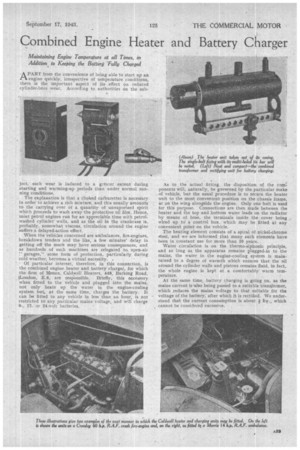Combined Engine Heater and Battery Charger
Page 35

If you've noticed an error in this article please click here to report it so we can fix it.
Maintaining Engine Temperature at all Times, in Addition to Keeping the Batterj Tully Charged APART from the convenience of being able to start up an engine quickly, irrespective of temperature conditions, there is the important aspect of its effect on reduced cylinder-bore wear. According to authorities on the sub
ject, such wear is induced to a greater extent during starting and warming-up periods than under normal running conditions.
The explanation is that a choked carburetter is necessary in order to achieve a rich mixture, and this usually amounts to the carrying over of a quantity of unvaporized spirit which proceeds to wash away-the protective oil film. Hence, most petrol engines run for an appreciable time with petrolwashed cylinder walls, and as the oil in the crankcase is, probably, somewhat viscous, •circulation around the engine suffers a delayed-action effect.
When the vehicles concerned are ambulances, fire-engines, breakdown tenders and the like, .a few minutes' delay in getting off the mark may have serious consequences, and as hundreds of such machines are relegated to. open-air l` garages," some form of protection, particularly during' cold weather, becomes a virtual necessity. .
• Of particular interest, therefore, in this connection, is the combined engine heater and battery charger, for which the firm of Messrs. Caldwell Heaters, 448, Barking Road, 1London, E.6, are responsible. Briefly, this accessory when fitted to the vehicle and plugged into the mains, not only heats up the water in the engine-cooling system but, at the same time, charges the battery. It can be fitted to any vehicle in less than an hour, is not restricted to any particular mains voltage, and will charge 6-, 12or 24-volt batteries.
As to the actual fitting, the disposition of the coin: ponents will, naturally, be governed by the particular make of vehicle, but the usual procedure is to secure the heater unit to the most convenient position on the chassis frame, Qr. on the wing alongside the engine. Only one bolt is used for this purpose. Connections are then made between the heater and the top and bottom water leads on the radiator by means of hose, the terminals inside the cover being wired up to a control box, which may be fitted at any convenient point on the vehicle.
The heating element consists of a spiral of nickel-chrome Jteel, and we are informed that many such elements have been in constant use for more than 10 years.
Water circulation is on the thermo-siphonic principle, and so long as the apparatus remains plugged-in to the mains, the water in the engine-cooling system is maintained to a degree of warmth which ensures that the oil around the cylinder walls and pistons remains fluid, in fact, the whole engine is kept at, a comfortably' warm temperature.
At the same time, battery charging is going on, as the mains current ivalso being passed to a suitable transformer, which seducei the mains voltage to that suitable for the voltage of the battery, after which it is rectified. We understand that the current consumption is about kw,, which cannot be considered excessive.




















































